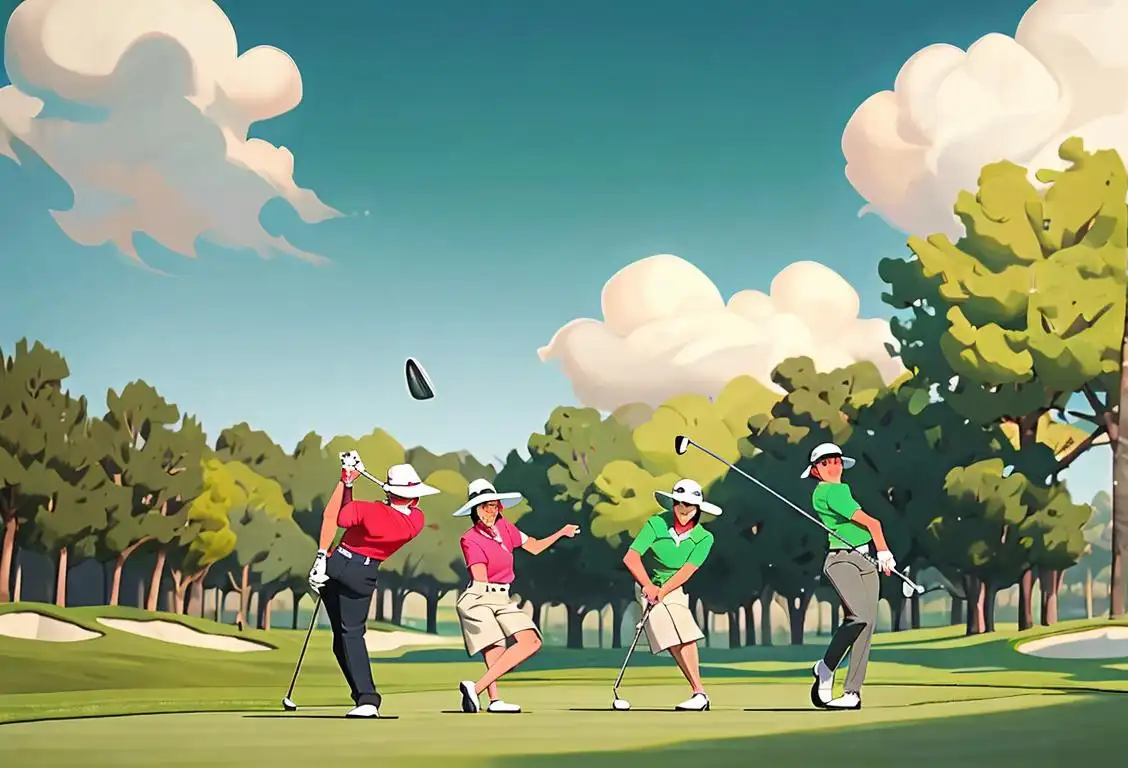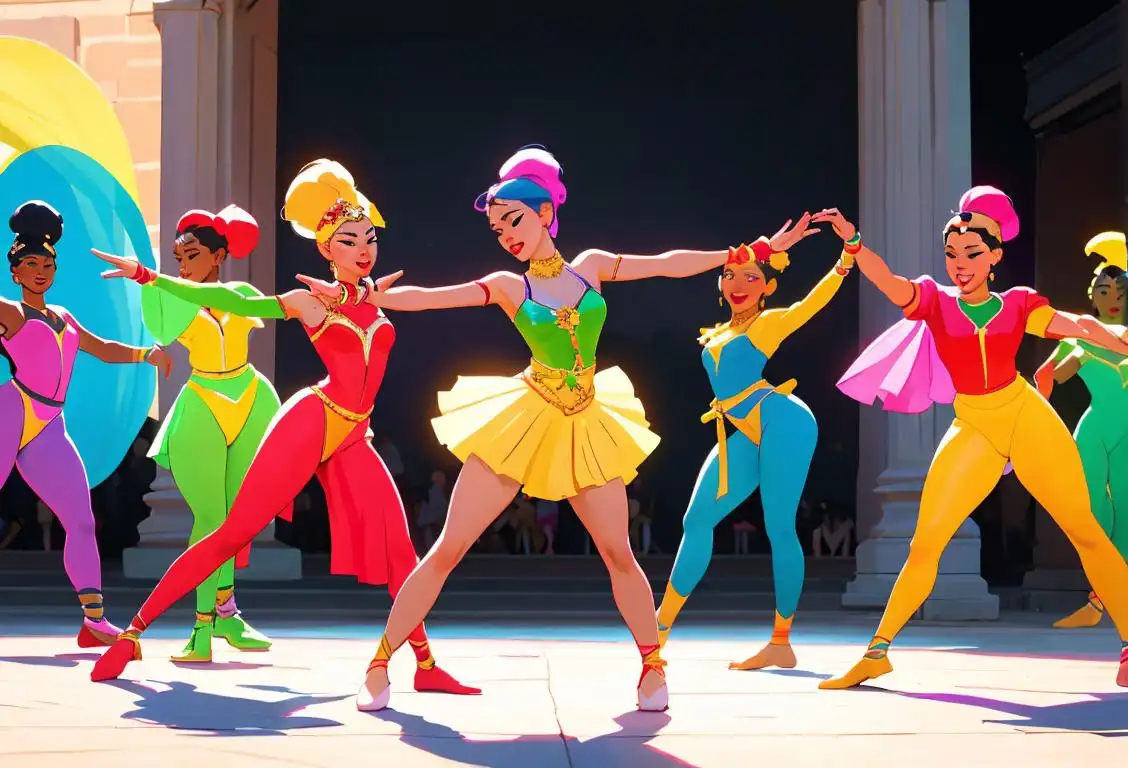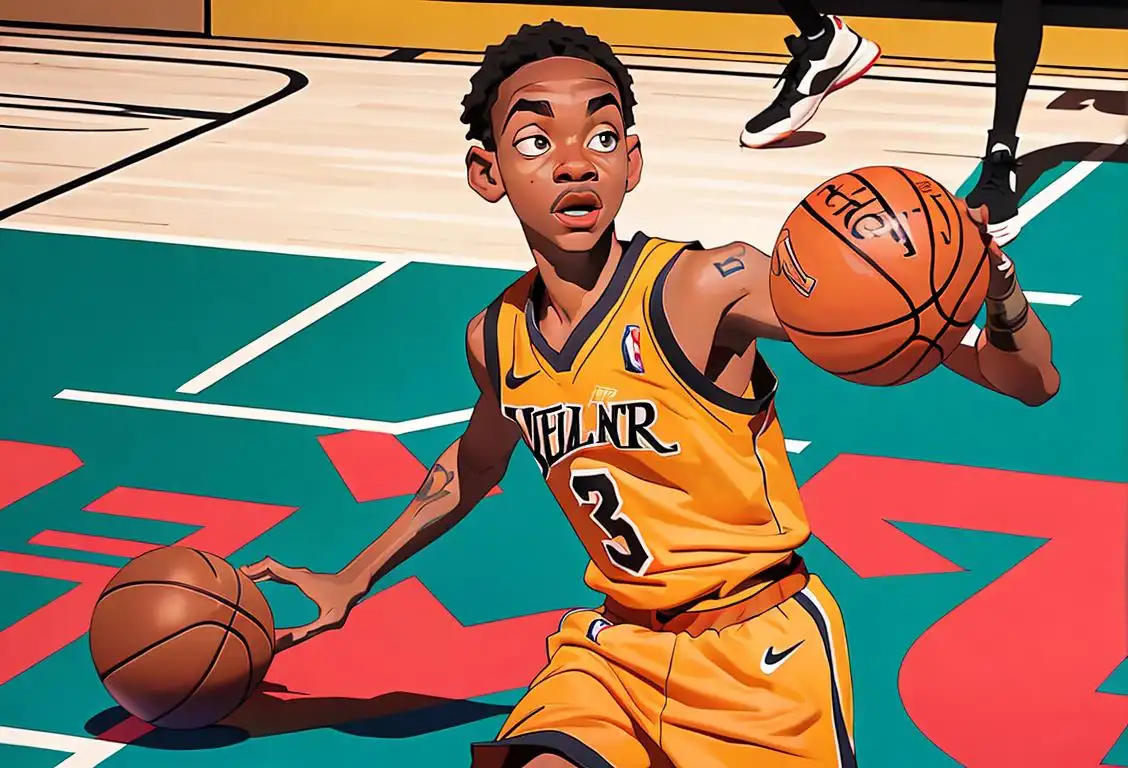National Yo Yo Day

Get ready to walk the dog, rock the baby, and walk the dog again, because it's National Yo Yo Day! This delightful holiday celebrates the joy and wonder of everyone's favorite stringed toy. So grab a yo-yo and join in on the fun!
When is Yo Yo Day?
It's national yo yo day on the 6th June.
The History of National Yo Yo Day
Believe it or not, the yo-yo has a rich and fascinating history that dates back thousands of years. Originating in ancient Greece, the yo-yo was originally used as a weapon. Yes, you heard that right! The yo-yo's early ancestors were used by warriors to distract and incapacitate their enemies. Imagine trying to fend off an attacking army while a bunch of guys are spinning yo-yos in your face. Talk about a challenging battle strategy!
However, the yo-yo as we know it today gained popularity in the 18th century, thanks to a Filipino toy called the 'bandalore.' American entrepreneur Donald F. Duncan, also known as the 'Father of the Yo-Yo,' brought the toy to the masses in the 1920s and made it a sensation. Since then, the yo-yo has become a beloved childhood symbol and a favorite pastime for people of all ages.
How to Celebrate National Yo Yo Day
Ready to show off your yo-yo skills? Here are a few ideas to make the most of National Yo Yo Day:
- Host a yo-yo competition with your family and friends. Let the battle for yo-yo supremacy begin!
- Learn some new yo-yo tricks. YouTube is chock-full of tutorials that will help you become a yo-yo master in no time.
- Visit a yo-yo museum. Yes, they actually exist! Check online to see if there's a yo-yo museum near you and indulge in some serious yo-yo nostalgia.
Why We Love National Yo Yo Day
National Yo Yo Day is more than just a celebration of a simple toy; it's a reminder of the joy and wonder we experienced as kids. It's a chance to reconnect with our inner child and embrace the simplicity and fun that yo-yos bring. Plus, let's be honest, few things are as satisfying as successfully pulling off an awesome yo-yo trick!
History behind the term 'Yo Yo'
1920
The First Modern Yo-Yo
The term 'yo-yo' originated in the 1920s when Pedro Flores, a Filipino immigrant living in the United States, invented and patented the first modern yo-yo. Flores popularized the term by producing and selling these toys as 'yo-yos', which became a huge hit among kids and adults alike. The word 'yo-yo' itself is believed to have descended from the Ilocano language of the Philippines, where it means 'come back.'
500 BCE
Ancient Beginnings
The origins of the yo-yo can be traced back to ancient Greece. Archaeological artifacts dating back to 500 BCE depict the existence of similar toys. These early toys were made of wood, metal, or terra cotta and were used for various purposes, such as religious rituals and as children's toys.
400 BC
Ancient Origins
The yo-yo dates back to ancient Greece in around 400 BC. Similar toys, such as terra-cotta disks with strings attached, were discovered in archaeological excavations. These ancient toys were likely used for simple spinning and tossing games.
500 BCE
Invention of the Yo-Yo
The term 'yo-yo' dates back to around 500 BCE in ancient Greece. The yo-yo as an object was invented during this time and was known as a 'pendulum toy.' It consisted of a disc with two holes, which was attached to a long piece of string. The Greeks used it for entertainment, but it was also used as a weapon in war, where it was swung around and thrown at enemies.
500 BCE
Ancient origins
The earliest precursor to the yo-yo can be traced back to ancient Greece, where a toy called a discus was popular amongst children. The discus was a round object made of wood, metal, or clay with strings attached to its sides. By pulling the strings and then letting go, children could make the discus spin and return to their hands.
500 BCE
Ancient Origins
The earliest mention of a yo-yo-like toy comes from ancient Greece. It was a simple device made of terra cotta, wood, or metal, consisting of two disks connected by an axle. Known as a 'bandalore' or 'quiz', it was used for various games and physical exercises.
500 BCE
Ancient Beginnings
The origins of the yo-yo can be traced back to ancient Greece. Historical evidence suggests that in around 500 BCE, the Greeks used a toy made of two discs connected by an axle. They called this early version of the yo-yo a 'pendulum' or 'rheotron.' However, the design of these primitive yo-yos was quite different from what we know today.
500 BCE
Ancient origins
The yo-yo is believed to have originated in ancient Greece, with depictions of children playing with similar toys appearing on ancient Greek vases dating back to around 500 BCE. These toys consisted of two disks connected by an axle, with a string attached to the axle. They were often made out of wood or terra cotta.
500 BCE
Ancient Invention
The origins of the yo-yo can be traced back to ancient Greece, where a toy similar to the modern yo-yo was crafted out of wood, metal, or terra cotta. This early version consisted of two disks connected by an axle, and it was called a 'bandalore'. It was used for various games and even had practical applications, such as a hunting tool.
1765
The Arrival of the Yo-Yo
The history of the term 'yo-yo' dates back to 1765 when it made its first appearance in the English language. The word originated from the Philippine language, Tagalog, where 'yo-yo' means 'come-come' or 'to return' - an appropriate name for this fascinating toy.
1866
Yo-Yo Spreads its Wings
The yo-yo was introduced to the Western world in 1866 when a Filipino named Pedro Flores immigrated to the United States. He brought with him the traditional Filipino toy and began manufacturing and selling it in Northern California. This marked the beginning of the yo-yo's popularity in the Western world.
16th century
Game of Skill in the Philippines
Fast forward to the 16th century in the Philippines, and we find evidence of a toy similar to the yo-yo called a 'bandalore.' It was composed of a round object tied to a string that could be manipulated to perform tricks. The bandalore was primarily used as a hunting weapon, to distract prey or ward off obstacles. This marked the first emergence of the yo-yo as a skill-based game.
16th century
Chinese Connection
In the 16th century, the yo-yo made its way to China, where it gained significant popularity. Known as the 'diabolo,' it was a rounded object with a hole in the center, and it was played with a string attached to two handheld sticks. The Chinese yo-yo was used for both entertainment and exercise.
16th Century
Yo-yo Spreads to Europe
During the 16th Century, the yo-yo made its way to Europe through traders and explorers. It gained popularity among the upper class and royals, who often used it as a fashionable accessory. The toy became known as a 'quiz' or 'bandalore' in Europe.
1928
Duncan Toys Acquires the Rights
In 1928, Donald F. Duncan acquired the rights to Pedro Flores' yo-yo design and trademarked the name 'yo-yo'. Duncan's company, Duncan Toys, became the leading manufacturer and distributor of yo-yos, playing a significant role in the popularization and commercial success of this toy. Under Duncan's leadership, yo-yo competitions and demonstrations gained immense popularity, showcasing the skillful tricks and stunts that could be performed with the toy.
16th Century
Arrival in the Philippines
During the 16th century, the yo-yo made its way to the Philippines through traders. It quickly gained popularity and became a traditional Filipino toy. The locals called it 'yo-yo,' which means 'come-come' or 'return' in their native language. The Filipino yo-yos were made of wood and had a different design compared to the Greek version.
500 CE
Yo-yo in China
The concept of the yo-yo made its way to China around the 5th century CE. Chinese yo-yos, known as 'diabolos,' were similar to the ancient Greek discus but had a center axle, allowing for even longer spin times. These diabolos had intricate designs and were often made of ivory, wood, or metal, demonstrating the artistry associated with them.
16th century
The Chinese influence
During the 16th century, the yo-yo made its way to China, where it evolved into a toy called the diabolo. The Chinese version consisted of two cups and a stick, which was manipulated to perform various tricks and stunts. The diabolo would later influence the design of the modern yo-yo.
16th Century
Reintroduction in Europe
The yo-yo found its way to Europe in the 16th century, brought back by travelers who encountered the toy in various Asian cultures. Its name derives from the Filipino word 'yoyo,' meaning 'come back,' which perfectly describes the toy's nature.
16th Century
Filipino Connection
The yo-yo as we know it today has its origins in the Philippines. Called the 'lul-lul', 'yoyo', or 'yoy-yoy', it was a hunting tool used by the native people. The toy consisted of a round object attached to a rope, which was thrown and retrieved using a finger loop.
1928
Trademark and Mass Production
In 1928, Pedro Flores, a Filipino immigrant in the United States, started the Yo-yo Manufacturing Company in Santa Barbara, California. Flores obtained a trademark for the name 'yo-yo' and began mass-producing them. This marked the first time yo-yos were made on a large scale.
1928
Trademarked as Yo-yo
In 1928, a Filipino immigrant named Pedro Flores trademarked the term 'yo-yo' and started the Yo-yo Manufacturing Company in the United States. He mass-produced yo-yos, introducing them to a wider audience. The term 'yo-yo' was derived from the Tagalog word 'yóyo', meaning 'come back'.
1765
European Introduction
The yo-yo reached Europe when it was brought back by travelers who encountered the toy in Asia. By the 18th century, the yo-yo had gained attention in France and England, where it was often referred to as a 'bandalore' or a 'quiz.' It became a popular pastime among the European elite.
16th century
Filipino influence
During the 16th century, the Spanish explorers introduced the yo-yo, known as 'bandalores,' to the Philippines. The Filipino people embraced this toy and developed a distinct style of play, incorporating various tricks and techniques. The yo-yo became deeply ingrained in their culture and was even used as a weapon by hunter-warriors for both hunting and self-defense.
1866
A New Name in France
In 1866, the modern term 'yo-yo' was popularized in France when two men from that country named Gustave Phillipart and Louis Marx patented a yo-yo-like toy. They named their creation 'l'Emigrette,' but soon after, people started referring to it as a 'yo-yo,' inspired by the Filipino term 'yóyo,' which means 'come-come' or 'to return.' This marked the moment when the name 'yo-yo' became associated with the toy.
1700s
European Introduction
During the 18th century, European explorers, traders, and missionaries encountered the yo-yo in the Philippines. They were captivated by its simplicity and brought it back to Europe, where it gained popularity as a novelty toy among the upper class.
1928
The Birth of Duncan Yo-Yo
In 1928, Donald F. Duncan, an American entrepreneur, came across the yo-yo and saw its potential. He started mass-producing and marketing yo-yos under the name 'Duncan Yo-Yo.' Duncan's marketing tactics, along with his sponsorship of yo-yo competitions, played a significant role in catapulting the popularity of the yo-yo to new heights.
1928
Yo-Yo Patent
In 1928, a Filipino-American entrepreneur named Pedro Flores popularized the toy in the United States. He established the Yo-yo Manufacturing Company and patented the term 'yo-yo.' Flores' yo-yos had a flat rim, making them ideal for performing tricks. He later sold his company to Duncan, who became a major manufacturer and marketer of yo-yos.
1962
Yo-Yo Renaissance
The 1960s marked a yo-yo renaissance as a new generation of kids became fascinated by this classic toy. Many yo-yo manufacturers emerged during this era, introducing various designs, materials, and innovations. The term 'yo-yo' started to become widely recognized as a symbol of playfulness, skill, and youthful fun.
19th century
The Filipino connection
The term 'yo-yo' is believed to have originated in the Philippines, where there is evidence of yo-yo-like toys being used as early as the 19th century. The Filipino yo-yo, called 'bandalore' or 'lubluban,' consisted of a spool attached to a string which was thrown and manipulated by the player. The term 'yo-yo' became popularized after it was introduced to the Western world by Filipino immigrant Pedro Flores in the early 20th century.
1928
Duncan's contribution
In 1928, a young entrepreneur named Donald F. Duncan encountered the yo-yo during a business trip to California. Recognizing its potential, he purchased the rights to the toy from Pedro Flores and began mass-producing yo-yos. Duncan's marketing strategies and widespread distribution helped popularize the yo-yo in the United States and eventually around the world.
1960s
Yo-Yo Craze
The 1960s witnessed a yo-yo craze in the United States, with millions of yo-yos sold and children mastering various tricks. Duncan, as the leading yo-yo company, introduced innovative designs and models, including the famous butterfly-shaped yo-yo. This period saw the rise of yo-yo competitions and the emergence of legendary yo-yo champions.
1960s
Yo-Yo Craze Sweeps the Nation
During the 1960s, the yo-yo experienced a massive resurgence in popularity. As children gravitated toward this fun and skillful toy, the yo-yo became a cultural sensation, not just in the United States but around the world. The yo-yo's versatility and the advent of various tricks and styles further contributed to its widespread appeal.
1928
Yo-yo Boom
The modern yo-yo as we know it today was patented by a Filipino-American named Pedro Flores. Flores established the Yo-yo Manufacturing Company in California, marking the beginning of a yo-yo craze in the United States. The toy quickly gained widespread popularity and became a cultural phenomenon.
1962
Yo-yo Craze
In 1962, Duncan Toys acquired the rights to Flores' trademark and popularized the yo-yo as a worldwide sensation. Duncan launched extensive marketing campaigns, making the yo-yo a must-have toy for children and adults alike. It became a cultural phenomenon, with yo-yo competitions, clubs, and even a Yo-Yo Hall of Fame being established.
1928
Yo-yo's modern name
The yo-yo, as we know it today, started gaining worldwide popularity in the late 1920s. It was during this time that Pedro Flores, a Filipino immigrant living in the United States, began manufacturing and selling yo-yos. He coined the term 'yo-yo,' which means 'come-come' in Tagalog, one of the main languages spoken in the Philippines.
1992
World Yo-Yo Contest
In 1992, the first World Yo-Yo Contest took place in the United States, solidifying yo-yo's status as a global phenomenon. This event attracted yo-yo enthusiasts from around the world, showcasing their incredible tricks and pushing the boundaries of what could be achieved with a yo-yo. The rise of the internet in the following years further fueled the yo-yo craze, leading to online communities, tutorials, and a newfound appreciation for this timeless toy.
1932
Duncan Toys Takes Over
In 1932, Donald F. Duncan Sr., an entrepreneur, bought the Yo-yo Manufacturing Company from Pedro Flores. Duncan further popularized the yo-yo by investing heavily in advertising and organizing yo-yo contests across the United States. The Duncan Yo-yo became immensely popular during this era.
1928
The Duncan Era Begins
In 1928, a young entrepreneur named Donald F. Duncan stumbled upon a yo-yo demonstration during a business trip to California. Impressed by the toy's potential, he acquired the rights to an existing yo-yo design and formed the 'Duncan Yo-Yo Company.' Under Duncan's reign, the yo-yo became wildly popular, with annual sales skyrocketing to millions of units in the following years. This era marked a turning point for the yo-yo, transforming it into a global craze.
19th century
American Adoption
In the 19th century, the yo-yo made its way to the United States. It was first used as a novelty item and was made of various materials, including metal, porcelain, and even rubber. However, it wasn't until Donald F. Duncan Sr., an entrepreneur, discovered the toy and brought it into the limelight that the yo-yo's popularity skyrocketed.
1960s
Yo-yo mania
The 1960s witnessed a yo-yo frenzy. Duncan Toys, a company founded in the 1920s, played a significant role in popularizing the toy during this era. Duncan yo-yos became a cultural phenomenon, with national contests, exhibitions, and even television advertisements showcasing the mesmerizing tricks that could be performed with this simple but versatile toy.
1999
Yo-Yo Returns with a Modern Twist
In 1999, a new yo-yo called the 'YoYoJam' revolutionized the world of yo-yoing. The YoYoJam featured a ball bearing, making it significantly easier to perform advanced tricks as compared to traditional fixed-axle yo-yos. This innovation sparked a renaissance in yo-yo design, leading to the creation of countless models catering to both casual players and competitive professionals.
1980s
Yo-yo Renaissance
The 1980s witnessed a resurgence of interest in yo-yos, with new designs and advanced tricks captivating a whole new generation. Professional yo-yo players emerged, showcasing jaw-dropping skills and pushing the boundaries of what could be done with the toy.
1998
Modern Yo-yo Evolution
In the late 1990s, yo-yo design took a leap forward with the introduction of the ball bearing axle system. This innovation allowed for longer spin times and enabled advanced tricks to be performed. Modern yo-yos come in various shapes, sizes, and materials, catering to the preferences of different players, whether they are beginners or professional competitors.
1999
World Yo-Yo Contest
The World Yo-Yo Contest, an annual event showcasing the best yo-yo talent from around the world, was established in 1999. It has since become a globally recognized competition, attracting participants from different countries. The contest features several yo-yo divisions and freestyle routines with mind-blowing tricks and incredible choreography.
1928
Trademarked as 'Yo-Yo'
In 1928, Donald F. Duncan Sr. trademarked the term 'Yo-Yo,' giving it an official name and making it synonymous with the toy we know today. Duncan's company, the Duncan Yo-Yo Company, played a pivotal role in popularizing the yo-yo worldwide.
1960s
Yo-yo boom
The 1960s saw a surge in yo-yo popularity, with various manufacturers introducing new designs and features. One notable development was the inclusion of a ball bearing axle, which allowed for longer and smoother spins. The yo-yo became a cultural phenomenon, with competitions, championships, and even a Yo-Yo craze that swept through the United States and other parts of the world.
2003
National Yo-Yo Day
In 2003, the American Yo-Yo Association established June 6th as National Yo-Yo Day to celebrate the joy and skill of yo-yoing. This day encourages people of all ages to pick up a yo-yo, learn tricks, and appreciate the cultural significance of this enduring toy. National Yo-Yo Day serves as a reminder of the rich history and continuous evolution of yo-yoing as a globally recognized pastime.
1960s
Yo-yo Renaissance
After a period of decline, the yo-yo experienced a resurgence in the 1960s. Duncan Toys, a company known for mass-producing yo-yos, introduced innovative designs and marketing campaigns, capturing the attention of a new generation. The yo-yo once again became a symbol of skill and entertainment.
1960
Yo-Yo Renaissance
After a period of decline in the mid-20th century, the yo-yo experienced a resurgence in the 1960s. This revival was largely fueled by the introduction of the 'string trick' yo-yo, which allowed for intricate tricks and stunts to be performed. The Yo-Yo Renaissance inspired a new generation of yo-yo enthusiasts and led to the creation of yo-yo competitions, showcasing the talent and creativity of players worldwide.
1999
Yo-Yo in the Digital Age
With the advent of the internet and online communities, yo-yoing found a new platform to thrive. The yo-yo community expanded, sharing trick tutorials, participating in forums, and organizing events. In 1999, the World Yo-Yo Contest was held for the first time, bringing together top players from around the globe. The digital age not only revitalized the yo-yo culture but also paved the way for innovative new designs and materials, pushing the boundaries of yo-yo performance.
1960s
Yo-Yo Mania
During the 1960s, the yo-yo experienced a resurgence in popularity. Duncan's yo-yos became a sensation, and competitions, demonstrations, and even TV shows showcasing yo-yo tricks were all the rage. The period was commonly known as the 'Yo-Yo Mania' or the 'Yo-Yo Craze,' with the toy capturing the imagination of people around the world.
1999
World Yo-Yo Contest
The World Yo-Yo Contest, held annually since 1992, showcases the incredible talent and creativity of yo-yo players from around the globe. Participants compete in various categories, including freestyle routines, demonstrating intricate tricks and impressive technical skills.
1999
Yo-yo in the modern era
In 1999, the modern yo-yo underwent a revolution with the advent of ball-bearing axles. This innovation allowed for longer spin times and more intricate tricks. Professional yo-yo players emerged, forming a dedicated community and participating in international competitions. Today, the yo-yo continues to captivate people of all ages, showcasing both skill and creativity.
21st century
Modern innovations
In recent years, the yo-yo has continued to evolve with modern innovations and advancements. Professional yo-yo players push the boundaries of what can be achieved with the toy, performing intricate tricks and stunts. Yo-yos now come in a variety of shapes, sizes, and materials, catering to different skill levels and preferences. The yo-yo remains a beloved toy and a symbol of skill, dexterity, and creativity.
1999
Yo-yo Diplomacy
In 1999, as part of an effort to promote cultural exchange, a delegation from the American Yo-Yo Association visited North Korea. This visit played a surprising role in fostering positive relations between the two countries, highlighting the power of this humble toy.
21st Century
Modern Innovations
In recent years, yo-yo technology has advanced significantly. Manufacturers have introduced ball bearings, weight rings, and other features to enhance performance and enable more complex tricks. The yo-yo community continues to grow, with dedicated enthusiasts and professional players pushing the boundaries of what is possible with this timeless toy.
21st century
Modern Evolution
In the 21st century, the yo-yo has evolved significantly. From the traditional fixed-axle yo-yos, modern yo-yos now feature ball bearings, adjustable response systems, and materials like aluminum and titanium. The toy has become a staple in the world of competitive yo-yoing, and professional yo-yo players continue to push the boundaries of what can be achieved with this simple yet versatile toy.
Did you know?
Did you know that the largest yo-yo ever made weighed a whopping 2,524 pounds? It was created by a group of yo-yo enthusiasts in the town of Himeji, Japan. Talk about a heavy-duty yo-yo!Tagged
fun sportsFirst identified
6th June 2016Most mentioned on
6th June 2019Total mentions
28Other days
Golf Day
Hunting And Fishing Day
Cancer Survivors Day
Fitness Day
Memorial Day
Gymnastics Day
Dance Day
Foundation Day
Jr Smith Day
Left Handers Day









